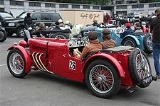
MG F-Type
Encyclopedia
The MG F-type Magna was a six cylinder engined car produced by the MG
MG (car)
The MG Car Company is a former British sports car manufacturer founded in the 1920s by Cecil Kimber. Best known for its two-seat open sports cars, MG also produced saloons and coupés....
Car company from October 1931 to 1932. It was also known as the 12/70.
Looking for a car to fill the gap between the M-Type Midget
MG M-type
The MG M-type was produced by the MG Car company from April 1929 to 1932. It was sometimes referred to as the 8/33. Launched at the 1928 London Motor Show when the sales of the larger MG saloons was faultering because of the economic climate, the small car brought MG ownership to a new sector of...
and the 18/80, MG turned to another of the engines that had become available from William Morris's acquisition of Wolseley
Wolseley Motor Company
The Wolseley Motor Company was a British automobile manufacturer founded in 1901. After 1935 it was incorporated into larger companies but the Wolseley name remained as an upmarket marque until 1975.-History:...
. This was the 1271 cc 6 cylinder version of the overhead camshaft
Overhead camshaft
Overhead cam valvetrain configurations place the engine camshaft within the cylinder heads, above the combustion chambers, and drive the valves or lifters in a more direct manner compared to overhead valves and pushrods...
engine used in the 1929 MG M type Midget and previously seen in the 1930 Wolseley Hornet
Wolseley Hornet (1930)
thumb|right|275px|1932 Wolseley Hornet EW SpecialThe Wolseley Hornet was a lightweight saloon car produced by the Wolseley Motor Company from 1930 to 1936...
and had dummy side covers to disguise its origins. Fitted with 1 in (3 cm) twin SU carburettors it produced 37.2 bhp at 4100 rpm at first, later increased to 47 bhp by revising the valve timing. Drive was to the rear wheels through a four speed non-synchromesh gearbox of ENV manufacture. The chassis was a 10 inches (254 mm) longer version of the one from the MG D-type with suspension by half elliptic springs and Hartford friction shock absorbers all round with rigid front and rear axles. Wire wheels with 4.00 x 19 tyres and centre lock fixing were used. The car had a wheelbase of 94 in (239 cm) and a track of 42 in (107 cm).
With its sloping radiator and long bonnet the F-Type is an attractive car capable of reaching 70 mi/h. 188 of the cars were supplied in chassis form to outside coachbuilders such as Abbey
Abbey (coachbuilder)
Abbey was a British coachbuilding business based in Merton, South West London and later Acton, North West London and was active between 1930 and about 1938....
, Jarvis, Stiles and Windover.
F
The original F was restricted by only having 8 inch (200 mm) brake drums which with its 4 seat bodies was not really adequate. Many F1 cars have subsequently been fitted with the larger F2 brakes.The four seat tourer cost £250 and the Foursome coupé cost £289.

